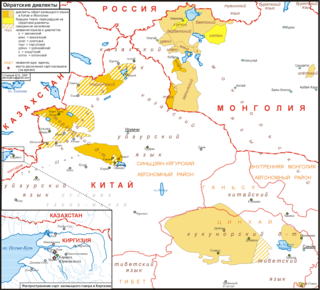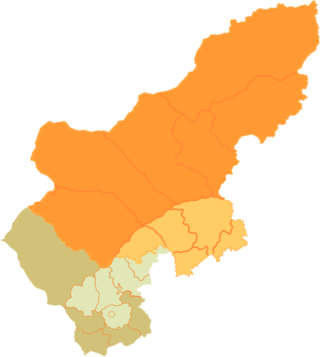
Altaic is a controversial proposed language family that would include the Turkic, Mongolic and Tungusic language families and possibly also the Japonic and Koreanic languages. The hypothetical language family has long been rejected by most comparative linguists, although it continues to be supported by a small but stable scholarly minority. Speakers of the constituent languages are currently scattered over most of Asia north of 35° N and in some eastern parts of Europe, extending in longitude from the Balkan Peninsula to Japan. The group is named after the Altai mountain range in the center of Asia.

The Mongols are an East Asian ethnic group native to Mongolia, China, as well as Buryatia and Kalmykia of Russia. The Mongols are the principal member of the large family of Mongolic peoples. The Oirats in Western Mongolia as well as the Buryats and Kalmyks of Russia are classified either as distinct ethno-linguistic groups or subgroups of Mongols.

Ural-Altaic, Uralo-Altaic, Uraltaic, or Turanic is a linguistic convergence zone and abandoned language-family proposal uniting the Uralic and the Altaic languages. It is now generally agreed that even the Altaic languages do not share a common descent: the similarities between Turkic, Mongolic and Tungusic are better explained by diffusion and borrowing. Just as in Altaic, the internal structure of the Uralic family has been debated since the family was first proposed. Doubts about the validity of most or all of the proposed higher-order Uralic branchings are becoming more common. The term continues to be used for the central Eurasian typological, grammatical and lexical convergence zone.

Mongolian is the principal language of the Mongolic language family that originated in the Mongolian Plateau. It is spoken by ethnic Mongols and other closely related Mongolic peoples who are native to modern Mongolia and surrounding parts of East and North Asia. Mongolian is the official language of Mongolia and Inner Mongolia and a recognized language of Xinjiang and Qinghai.

The Mongolic languages are a language family spoken by the Mongolic peoples in Eastern Europe, Central Asia, North Asia and East Asia, mostly in Mongolia and surrounding areas and in Kalmykia and Buryatia. The best-known member of this language family, Mongolian, is the primary language of most of the residents of Mongolia and the Mongol residents of Inner Mongolia, with an estimated 5.7+ million speakers.
Khitan or Kitan, also known as Liao, is an extinct language once spoken in Northeast Asia by the Khitan people. It was the official language of the Liao Empire (907–1125) and the Qara Khitai (1124–1218).
The Kangjia language is a Mongolic language spoken by a Muslim population of around 300 people in Jainca (Jianzha) County, Huangnan Tibetan Autonomous Prefecture in Qinghai province of China. As to its taxonomic affiliation, Kangjia seems to be an intermediate between Bonan language and Santa language (Dongxiang).

Oirat is a Mongolic language spoken by the descendants of Oirat Mongols, now forming parts of Mongols in China, Kalmyks in Russia and Mongolians. Largely mutually intelligible to other core Central Mongolic languages, scholars differ as to whether they regard Oirat as a distinct language or a major dialect of the Mongolian language. Oirat-speaking areas are scattered across the far west of Mongolia, the northwest of China and Russia's Caspian coast, where its major variety is Kalmyk. In China, it is spoken mainly in Xinjiang, but also among the Deed Mongol of Qinghai and Subei County in Gansu.
The classification of the Japonic languages and their external relations is unclear. Linguists traditionally consider the Japonic languages to belong to an independent family; indeed, until the classification of Ryukyuan and eventually Hachijō as separate languages within a Japonic family rather than as dialects of Japanese, Japanese was considered a language isolate.
The Khalkha dialect is a dialect of central Mongolic widely spoken in Mongolia. According to some classifications, the Khalkha dialect includes Southern Mongolian varieties such as Shiliin gol, Ulaanchab and Sönid. As it was the basis for the Cyrillic orthography of Mongolian, it is de facto the national language of Mongolia. The name of the dialect is related to the name of the Khalkha Mongols and the Khalkha river.
Middle Mongol or Middle Mongolian was a Mongolic koiné language spoken in the Mongol Empire. Originating from Genghis Khan's home region of Northeastern Mongolia, it diversified into several Mongolic languages after the collapse of the empire. In comparison to Modern Mongolian, it is known to have had no long vowels, different vowel harmony and verbal systems and a slightly different case system.
Torgut, also spelled Torghud, is a dialect of the Oirat language spoken in Xinjiang, in western Mongolia and in eastern Kalmykia. Thus, it has more speakers than any other variety of Oirat. It is better researched than any other Oirat variety spoken in China.

Chakhar is a variety of Mongolian spoken in the central region of Inner Mongolia. It is phonologically close to Khalkha and is the basis for the standard pronunciation of Mongolian in Inner Mongolia.
In the Inner Mongolia Autonomous Region of China, the Mongolian language is the official provincial language. Mongols are the second largest ethnic group, comprising about 17 percent of the population. There are at least 4.1 million ethnic Mongols in Inner Mongolia, including subgroups like the Chahars, Ordos, Baarin, Khorchin, Kharchin, and Buryats. While there is a standardized dialect of the Mongolian language in Inner Mongolia, different Mongolian dialects continue to be spoken by different subgroups of the Mongols. Some proposed the Peripheral Mongolian dialect group to cover the Mongolian dialects in Inner Mongolia.
Baarin is a dialect of Mongolian spoken mainly in Inner Mongolia.
Juha Janhunen is a Finnish linguist whose wide interests include Uralic and Mongolic languages. Since 1994, he has been Professor in East Asian studies at the University of Helsinki. He has done fieldwork on Samoyedic languages and on Khamnigan Mongol. More recently, he has collaborated with Chinese scholar Wu Yingzhe to produce a critical edition of two newly discovered Liao Dynasty epitaphs written in the Khitan small script. Janhunen has also worked along with Ekaterina Gruzdeva on revitalizing the Nivkh language.
Para-Mongolic is a proposed group of languages that is considered to be an extinct sister branch of the Mongolic languages. Para-Mongolic contains certain historically attested extinct languages, among them Khitan and Tuyuhun.
Serbi–Mongolic is a proposed group of languages that includes the Mongolic languages as well as the Para-Mongolic languages, a proposed extinct sister branch of the Mongolic languages.
Ang is a letter of related and vertically oriented alphabets used to write Mongolic and Tungusic languages.
The Qinghai–Gansu sprachbund or Amdo sprachbund is a sprachbund in the plateau traversed by the upper Yellow River, including northeastern Qinghai and southern Gansu. This has long been an area of interaction between speakers of northwestern varieties of Mandarin Chinese, Amdo Tibetan and Mongolic and Turkic languages. These families feature contrasting typologies, which spread between languages in the region. The languages have come to share many features, and differ significantly from their relatives outside the region.







